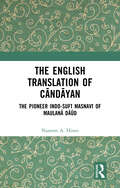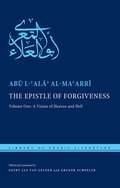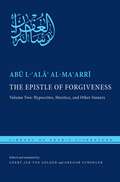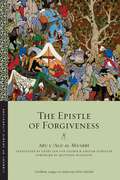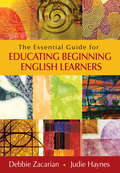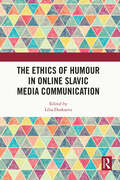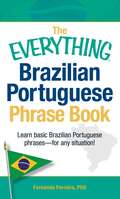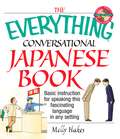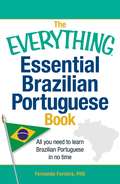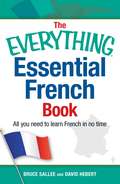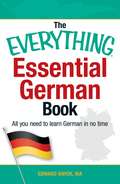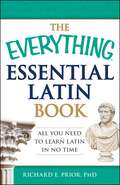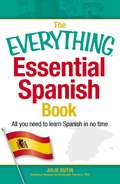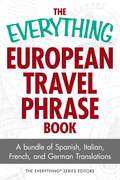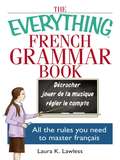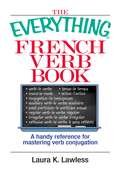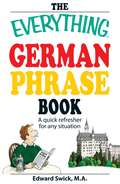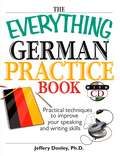- Table View
- List View
The English Translation of Cāndāyan: The Pioneer Indo-Sufī Masnavī of Maulanā Dāūd
by Naseem A. HinesThis book is the first English translation of Cāndāyan, the pioneer work in a long tradition of Indian-Sufi love narratives. The story was adapted from an oral epic Chanaini, popular in the Awadhi speaking region of north India in the fourteenth century. The early manuscripts of Cāndāyan, though composed in the Awadhi dialect, were recorded in the Persian script. Each stanza-like unit is introduced by a phrase or sentences in the Persian language style, making it necessary for a reader to know the Persian script and language, as well as the Awadhi dialect. This somewhat limits the access to fully explore Cāndāyan. In addition to this, the esoteric interpretation, which is the distinguishing feature that gives the Indian-Sufi masnavī literature its unique identity, was also not yet realized. Cāndāyan deserves to be celebrated and recognized because it marks the beginning of the indigenizing process of the masnavī in India, and served as a model for this literary genre for the next 540 years. A serious study of Maulana Daud’s Cāndāyan, composed in 1379, in the reign of Firoz Shah Tughlaq, did not begin until well into the twentieth century because only a few pages of its manuscript folios were discovered at a time, in various academic institutions and museums around the world. Cāndāyan is a fascinating study of the blending of the features of the Persian masnavī with the features of the Hindi premākhyān narratives and the features of the medieval Jain literature. Even today, annually in the Mahakoshala region Cāndāyan is presented in the form of drama and in the folk-song and play forms. Print edition not for sale in South Asia (India, Sri Lanka, Nepal, Bangladesh, Pakistan and Bhutan)
The Epistle of Forgiveness: Volume One: A Vision of Heaven and Hell (Library of Arabic Literature #32)
by Abū l-ʿAlāʾ al-MaʿarrīOne of the most unusual books in classical Arabic literature, The Epistle of Forgiveness is the lengthy reply by the prolific Syrian poet and prose writer Abu l-'Ala' al-Ma'arri (d. 449/1057), to a letter written by an obscure grammarian, Ibn al-Qarih. With biting irony, The Epistle of Forgiveness mocks Ibn al-Qarih's hypocrisy and sycophancy by imagining he has died and arrived with some difficulty in Heaven, where he meets famous poets and philologists from the past. He also glimpses Hell, and converses with the Devil and various heretics. Al-Ma'arri—a maverick, a vegan, and often branded a heretic himself—seems to mock popular ideas about the Hereafter. This book, the first of two volumes, includes Ibn al-Qarih’s initial letter to al-Ma'arri, as well as the first half of The Epistle of Forgiveness.This translation is the first complete translation in any language and retains the many digressions, difficult passages, and convoluted grammatical discussions of the original typically omitted in other translations. It is accompanied by a comprehensive introduction and detailed annotation. Replete with erudite commentary, amusing anecdotes, and sardonic wit, The Epistle of Forgiveness is an imaginative tour-de-force by one of the most pre-eminent figures in classical Arabic literature.A bilingual Arabic-English edition.
The Epistle of Forgiveness: Volume Two: Hypocrites, Heretics, and Other Sinners (Library of Arabic Literature #36)
by Abū l-ʿAlāʾ al-MaʿarrīOne of the most unusual books in classical Arabic literature, The Epistle of Forgiveness is the lengthy reply by the prolific Syrian poet and prose writer, Abu l-'Ala' al-Ma'arri (d. 449/1057), to a letter by an obscure grammarian, Ibn al-Qarih. With biting irony, The Epistle of Forgiveness mocks Ibn al-Qarih’s hypocrisy and sycophancy by imagining he has died and arrived with some difficulty in Heaven, where he meets famous poets and philologists from the past. He also glimpses Hell, and converses with the Devil and various heretics. Al-Ma'arri—a maverick, a vegan, and often branded a heretic himself—seems to mock popular ideas about the Hereafter. This second volume is a point-by-point reply to Ibn al-Qarih’s letter using al-Ma'arri’s characteristic mixture of erudition, irony, and admonition, enlivened with anecdotes and poems. Among other things, he writes about hypocrites; heretical poets, princes, rebels, and mystics; apostates; piety; superstition; the plight of men of letters; collaborative authorship; wine-drinking; old age; repentance; pre-Islamic pilgrimage customs; and money. This remarkable book is the first complete translation in any language, all the more impressive because of al-Ma'arri’s highly ornate and difficult style, his use of rhymed prose, and numerous obscure words andexpressions.A bilingual Arabic-English edition.
The Epistle of Forgiveness: Volumes One and Two (Library of Arabic Literature #29)
by Abū l-ʿAlāʾ al-MaʿarrīKnown as “one of the most complex and unusual texts in Arabic literature” (Banipal Magazine), The Epistle of Forgiveness is the lengthy reply by the prolific Syrian poet and prose writer, Abu l-'Ala' al-Ma'arri (d. 449/1057), to a letter by an obscure grammarian, Ibn al-Qari. With biting irony, The Epistle of Forgiveness mocks Ibn al-Qari’s hypocrisy and sycophancy by imagining he has died and arrived with some difficulty in Heaven, where he meets famous poets and philologists from the past. In al-Ma'arri’s imaginative telling, Ibn al-Qari also glimpses Hell and converses with the Devil and various heretics.Al-Ma'arri—a maverick, a vegan, and often branded a heretic himself—seems to mock popular ideas about the Hereafter. Among other things, he introduces us to hypocrites, poets, princes, rebels, mystics, and apostates, with asides on piety, superstition, wine-drinking, old age, and other topics. This remarkable book is the first complete translation of this masterpiece into any language, all the more impressive because of Al-Ma'arri's highly ornate and difficult style, his use of rhymed prose, and his numerous obscure words and expressions. Replete with erudite commentary, amusing anecdotes, and sardonic wit, The Epistle of Forgiveness is an imaginative tour-de-force by one of the most pre-eminent figures in classical Arabic literature. An English-only edition.
The Essential Guide for Educating Beginning English Learners
by Debbie Zacarian Judie HaynesPut all English learners on the path to success—right from the start! As more beginning ELs enroll in schools every year, educators need a realistic framework for addressing the varied needs of this growing population. In this practical resource, the authors provide templates, tools, and vignettes illustrating real-world challenges to help teachers and administrators: Learn strategies for teaching beginning level ELs across the curriculum Create a welcoming environment for students and families Reach out to students from both literacy and non-literacy-oriented homes Design programs that meet the needs of beginning ELs and students with limited or interrupted formal education (SLIFE)
The Ethics of Humour in Online Slavic Media Communication
by Duskaeva LiliaThe Ethics of Humour in Online Slavic Media Communication is devoted to research on how the rules of humour used online media are changing and how these changes rearrange the traditions of speech interaction in media communication. The authors of the book are experienced researchers in the field of Slavic media linguistics and represent five neighbouring countries: Russia, Belarus, Lithuania, Slovakia, and Poland. The research in the volume is based on the data from Slavic languages. The diversity and, at the same time, relative proximity of Slavic languages makes it possible to put separate studies into a wider comparative context, in order to reveal the general and ethno-cultural patterns in using means of communicative etiquette; it helps define the ethno-cultural factors behind the formation of such means. Speech practice of humour creation shows the creative potential of all languages, including the ones with a small number of speakers – Slovak and Belarusian, which have the status of state languages, but are strongly influenced by international languages (English and Russian). This volume is a valuable resource for researchers in the field of Slavic studies.
The Everything Brazilian Portuguese Phrase Book
by Fernanda FerreiraThe ultimate phrase guide for travel, business, and more! "I'll have the chicken dish, please." "How do you get to the theater?" "Let's set up a meeting." Packed with everything you'll need to understand--and be understood by--Brazilian-Portuguese speakers, this pocket guide is the ultimate translator to have on an airplane, in a boardroom, at a restaurant, and anywhere else this beautiful language is spoken. Conveniently organized by subject and situation, this handy guide includes information on: How to make introductions, professionally and casually Ordering food in restaurants (with phrases for special diets and allergies) Asking for and giving directions Explaining medical emergencies to doctors Crafting status updates and tweets online Slang phrases for casual chatting Complete with Brazilian Portuguese-English and English-Brazilian Portuguese dictionaries for quick reference, The Everything Brazilian Portuguese Phrase Book gives you the right words and phrases--whatever the situation!
The Everything Brazilian Portuguese Phrase Book
by Fernanda FerreiraThe ultimate phrase guide for travel, business, and more! "I'll have the chicken dish, please." "How do you get to the theater?" "Let's set up a meeting." Packed with everything you'll need to understand--and be understood by--Brazilian-Portuguese speakers, this pocket guide is the ultimate translator to have on an airplane, in a boardroom, at a restaurant, and anywhere else this beautiful language is spoken. Conveniently organized by subject and situation, this handy guide includes information on: How to make introductions, professionally and casually Ordering food in restaurants (with phrases for special diets and allergies) Asking for and giving directions Explaining medical emergencies to doctors Crafting status updates and tweets online Slang phrases for casual chatting Complete with Brazilian Portuguese-English and English-Brazilian Portuguese dictionaries for quick reference, The Everything Brazilian Portuguese Phrase Book gives you the right words and phrases--whatever the situation!
The Everything Brazilian Portuguese Phrase Book: Learn Basic Brazilian Portuguese Phrases - For Any Situation!
by Fernanda FerreiraThe ultimate phrase guide for travel, business, and more!"I'll have the chicken dish, please." "How do you get to the theater?" "Let's set up a meeting."Packed with everything you'll need to understand--and be understood by--Brazilian-Portuguese speakers, this pocket guide is the ultimate translator to have on an airplane, in a boardroom, at a restaurant, and anywhere else this beautiful language is spoken. Conveniently organized by subject and situation, this handy guide includes information on:How to make introductions, professionally and casuallyOrdering food in restaurants (with phrases for special diets and allergies)Asking for and giving directionsExplaining medical emergencies to doctorsCrafting status updates and tweets onlineSlang phrases for casual chattingComplete with Brazilian Portuguese-English and English-Brazilian Portuguese dictionaries for quick reference, The Everything Brazilian Portuguese Phrase Book gives you the right words and phrases--whatever the situation!
The Everything Conversational Japanese Book
by Molly HakesWith the globalization of business and the advancement of international trade, learning a foreign language is quickly becoming more and more essential for advancement in today's world. The Everything Conversational Japanese Book, teaches you how to master one of the most predominant languages in business and secure you an unparalleled edge in the job market. Understanding cultural references, learning correct pronunciation, and giving an effective introduction are all a cinch with this all-inclusive guide. Featuring exercises and quizzes at the end of each chapter, The Everything Conversational Japanese Book prepares you for any situation and enables you to carry on a basic conversation in very little time. The Everything Conversational Japanese Book helps you: Use appropriate tone Master vocabulary Communicate in a business or casual setting Respond effectively Understand and appreciate Japanese culture Whether you're just visiting Japan or wish to further your career opportunities by learning another language, The Everything Conversational Japanese Book is your jumpstart to speaking Japanese quickly and with confidence.
The Everything Conversational Japanese Book: Basic Instruction For Speaking This Fascinating Language In Any Setting
by Molly HakesA Simon & Schuster eBook. Simon & Schuster has a great book for every reader.
The Everything Essential Brazilian Portuguese Book
by Fernanda FerreiraBrazilian Portuguese made fun--and fast! Whether you are planning a vacation, adding a valuable second language to your resume, or simply brushing up on your skills, The Everything Essential Brazilian Portuguese Book is your perfect introduction to the Portuguese language. With easy-to-follow instructions and simple explanations, this portable guide covers the most important basics of the language, including: The Portuguese alphabet and translation Greetings and conversation starters Common questions and answers Describing people and places Verb tenses and sentence structure Basic conversation skills for dining out, conducting business, or shopping With The Everything Essential Brazilian Portuguese Book, you will be speaking--and understanding--Portuguese in no time!
The Everything Essential Brazilian Portuguese Book: All You Need to Learn Brazilian Portuguese in No Time!
by Fernanda FerreiraBrazilian Portuguese made fun--and fast!Whether you are planning a vacation, adding a valuable second language to your resume, or simply brushing up on your skills, The Everything Essential Brazilian Portuguese Book is your perfect introduction to the Portuguese language. With easy-to-follow instructions and simple explanations, this portable guide covers the most important basics of the language, including:The Portuguese alphabet and translationGreetings and conversation startersCommon questions and answersDescribing people and placesVerb tenses and sentence structureBasic conversation skills for dining out, conducting business, or shoppingWith The Everything Essential Brazilian Portuguese Book, you will be speaking--and understanding--Portuguese in no time!
The Everything Essential French Book: All You Need to Learn French in No Time (Everything® Series)
by Bruce Sallee David HebertAll the basics of French--fast and easy!Whether you are planning a vacation, adding a valuable second language to your resume, or simply brushing up on your skills, The Everything Essential French Book is your perfect introduction to the French language. With easy-to-follow instructions and simple explanations, this portable guide covers the most important basics, including:The French alphabet, accents, and translation.Common French phrases and greetings.Everyday questions and answers.Verb tenses and sentence structure.How to place an order and give commands.The Everything Essential French Book has all you need to get from bonjour to au revoir in no time!
The Everything Essential German Book: All You Need to Learn German in No Time! (Everything® Series)
by Edward SwickLearn to speak and write German like a pro!Need a quick introduction to the German language? Whether you're planning a vacation, adding a valuable second language to your resume, or simply brushing up on your skills, The Everything Essential German Book is your perfect guide for learning to speak and write in German. This portable guide covers the most important basics, including:The German alphabet and translationGreetings and conversation startersCommon questions and answersVerb tenses and sentence structureWith step-by-step instructions, pronunciation guides, and practical exercises, you'll find learning German can be easy and fun! You'll be speaking--and understanding--German in no time!
The Everything Essential Latin Book
by Richard E. PriorThe basics of Latin made fun--and fast! Learning the basics of Latin can vastly improve your vocabulary and even provide keys to understanding legal, medical, and scientific terminology. The Everything Essential Latin Book is your perfect introduction to this fascinating language. With easy-to-follow instructions and simple explanations, this portable guide covers the most important basics of Latin, including: The Roman alphabet and translation The all-important syntax of Latin Getting someone's attention and giving commands Common questions and answers Describing people and places Verb tenses Grammatical voice With The Everything Essential Latin Book, you'll be speaking like an ancient Roman in no time!
The Everything Essential Latin Book: All You Need to Learn Latin in No Time
by Richard E PriorThe basics of Latin made fun--and fast!Learning the basics of Latin can vastly improve your vocabulary and even provide keys to understanding legal, medical, and scientific terminology. The Everything Essential Latin Book is your perfect introduction to this fascinating language. With easy-to-follow instructions and simple explanations, this portable guide covers the most important basics of Latin, including:The Roman alphabet and translationThe all-important syntax of LatinGetting someone's attention and giving commandsCommon questions and answersDescribing people and placesVerb tensesGrammatical voiceWith The Everything Essential Latin Book, you'll be speaking like an ancient Roman in no time!
The Everything Essential Spanish Book: All You Need to Learn Spanish in No Time
by Julie GutinLearning Spanish can be easy and fun!Hola! If you've always wanted to learn Spanish, here's a quick and easy way to get started. Whether you're planning a vacation in Mexico or adding a valuable second language to your resume, The Everything Essential Spanish Book will help you order the right dish in a restaurant, answer customer's questions, or converse with locals when traveling.With easy-to-follow instructions and simple explanations, this portable guide covers the most important Spanish basics, including:The Spanish alphabet and translationGreetings and conversation startersCommon questions and answersVerb tenses and sentence structure Don't just learn to repeat words and key phrases--learn to understand them on your own terms and at your own speed. The simple step-by-step approach and lively examples will have you speaking--and understanding--Spanish in no time!
The Everything European Travel Phrase Book
by The Everything Series Editors¿Dónde está la estación de trenes?Dov'è la stazione?Où est la gare?Wo ist der Bahnhof?There's too much to see as you travel through Europe to waste time being lost in translation. Add The Everything European Travel Phrase Book to your e-library and you'll never be at a loss for the right words again. Whether you're looking for the train station or ordering your dinner, you'll find exactly what you need in this handy multi-language reference. With translations in Spanish, Italian, French, and German, you'll be ready to go wherever the Eurail takes you.
The Everything European Travel Phrase Book: A Bundle of Spanish, Italian, French, and German Translations
by The Everything Series Editors¿Dónde está la estación de trenes?Dov’è la stazione?Où est la gare?Wo ist der Bahnhof?There's too much to see as you travel through Europe to waste time being lost in translation. Add The Everything European Travel Phrase Book to your e-library and you'll never be at a loss for the right words again. Whether you're looking for the train station or ordering your dinner, you'll find exactly what you need in this handy multi-language reference. With translations in Spanish, Italian, French, and German, you'll be ready to go wherever the Eurail takes you.
The Everything French Grammar Book
by Laura K LawlessThe Everything French Grammar Book provides readers with easy-to-follow lessons on the rules, syntax, and sentence structure of the French language. From punctuation to pronouns, this handy reference walks readers through the basics of proper French speaking. Step-by-step instruction, fun reinforcement exercises, and clever mnemonic clues help readers master conjugation, tense use, and sentence structure quickly! Complete with verb charts, The Everything French Grammar Book is the perfect reference for the Gallic enthusiast.
The Everything French Verb Book: A Handy Reference For Mastering Verb Conjugation (Everything®)
by Laura K LawlessVerb recognition and conjugation is one of the most difficult aspects of learning any language - especially French. But with The Everything French Verb Book, mastering those idiomatic verbs is a cinch! You'll not only learn basic and advanced verbs and how to use them, you'll also learn the subtleties that distinguish similar verbs.Enhance your French now with:A complete conjugated glossary of more than 1,200 verbsProper pronunciation guidance for flawless speechStrategies for recognizing and using verbs with easeSpecial verbs, idiomatic expressions, and prepositionsPractical instruction on simple and compound conjugationsWith easy-to-follow instruction that explains the nuances of tense usage and etiquette-appropriate language, you'll be speaking this splendid romance language with ease and confidence in no time. Impress your friends, travel to French-speaking countries, or wander through a Parisian marketplace - all you need is The Everything French Verb Book!
The Everything German Phrase Book: A quick refresher for any situation (Everything® Series)
by Edward SwickTravelers need more than danke schön to get around Germany. Featuring hundreds of commonly used phrases, this pocket-sized guide provides travellers with the words they need in any setting. They will be able to order dinner, talk on the phone, read street signs and train schedules, and shop with confidence. This book even features the basics of German grammar and pronunciation as well as common idioms and slang words. Conveniently organized and indexed by category, this quick reference guide is all travellers need to make the most of their trips.
The Everything German Practice
by Jeffery DonleyThe Everything German Practice Book has all it takes for beginner and intermediate speakers to take their proficiency to the next level. Divided into 10 easy-to-follow sections, this fun and accessible guide boasts more than 200 exercises designed to speed the reader's mastery of:Grammar, syntax, and sentence structureVocabulary-building methodsPronunciation and usage techniqueComprehension in reading and speakingPLEASE NOTE:The ebook version of this title does not include a CD or contain interactive audio exercises.
The Everything German Practice: Practical Techniques to Improve Your Speaking And Writing Skills
by Jeffery DonleyThe Everything German Practice Book has all it takes for beginner and intermediate speakers to take their proficiency to the next level. Divided into 10 easy-to-follow sections, this fun and accessible guide boasts more than 200 exercises designed to speed the reader's mastery of:Grammar, syntax, and sentence structureVocabulary-building methodsPronunciation and usage techniqueComprehension in reading and speakingPLEASE NOTE:The ebook version of this title does not include a CD or contain interactive audio exercises.
